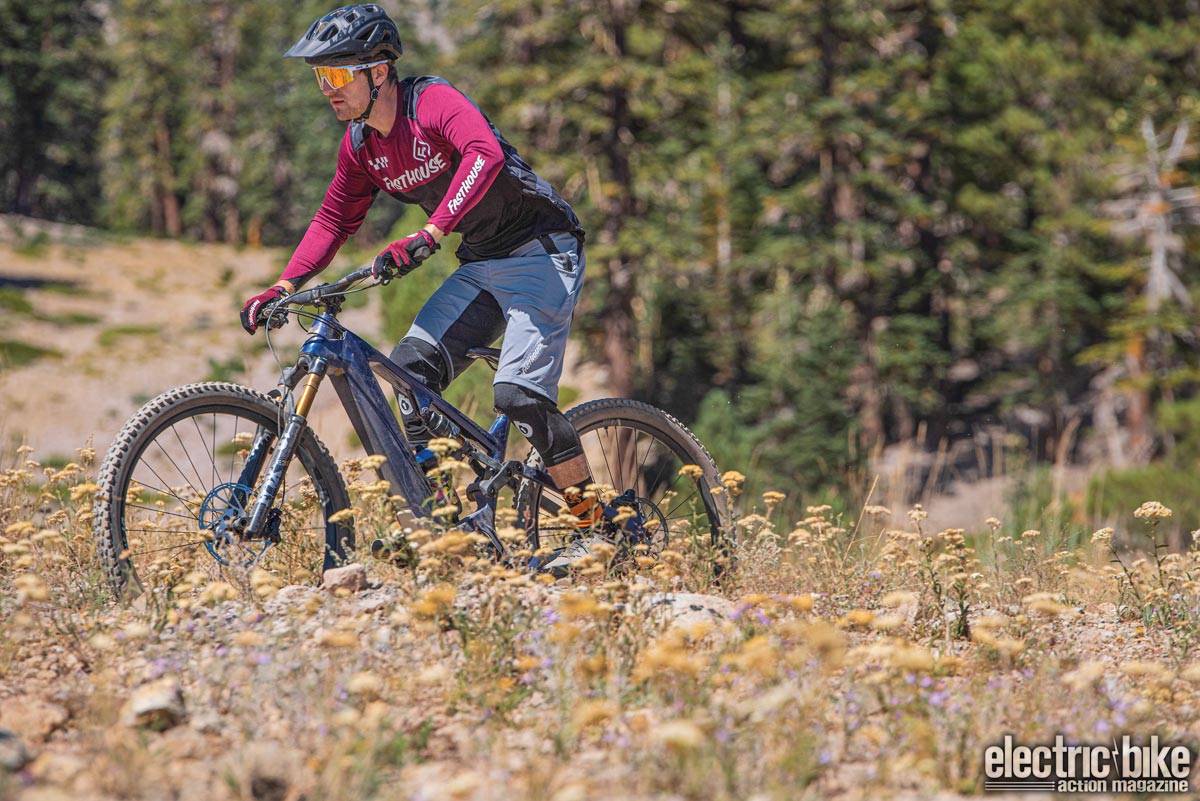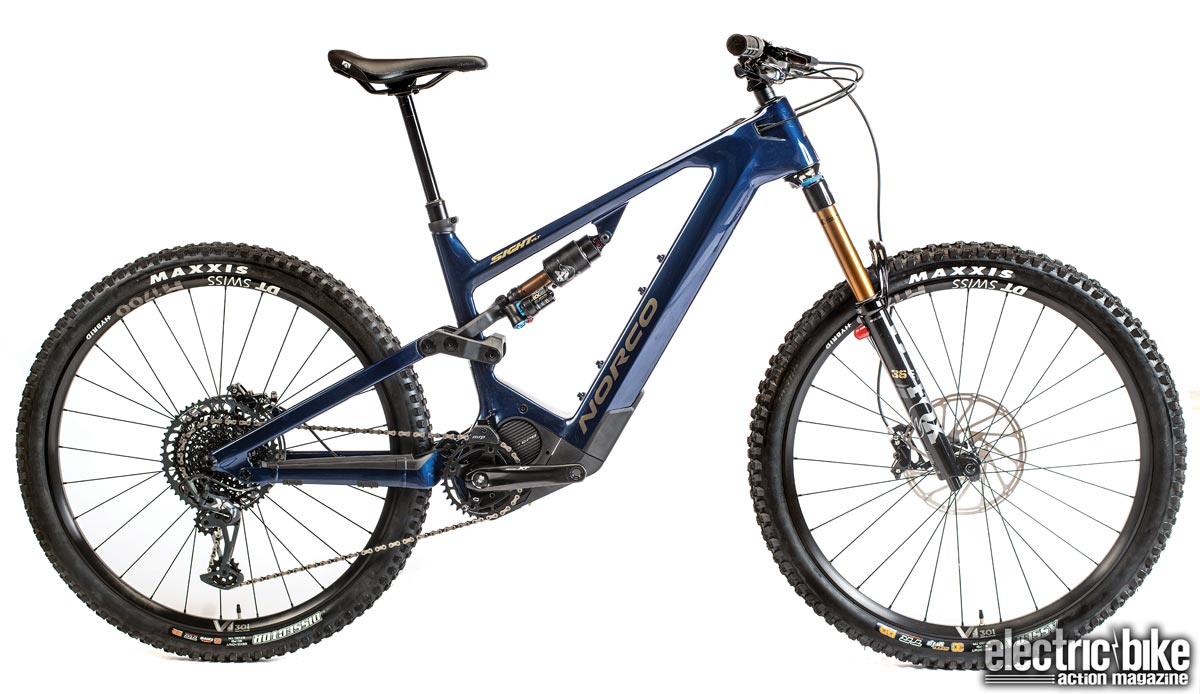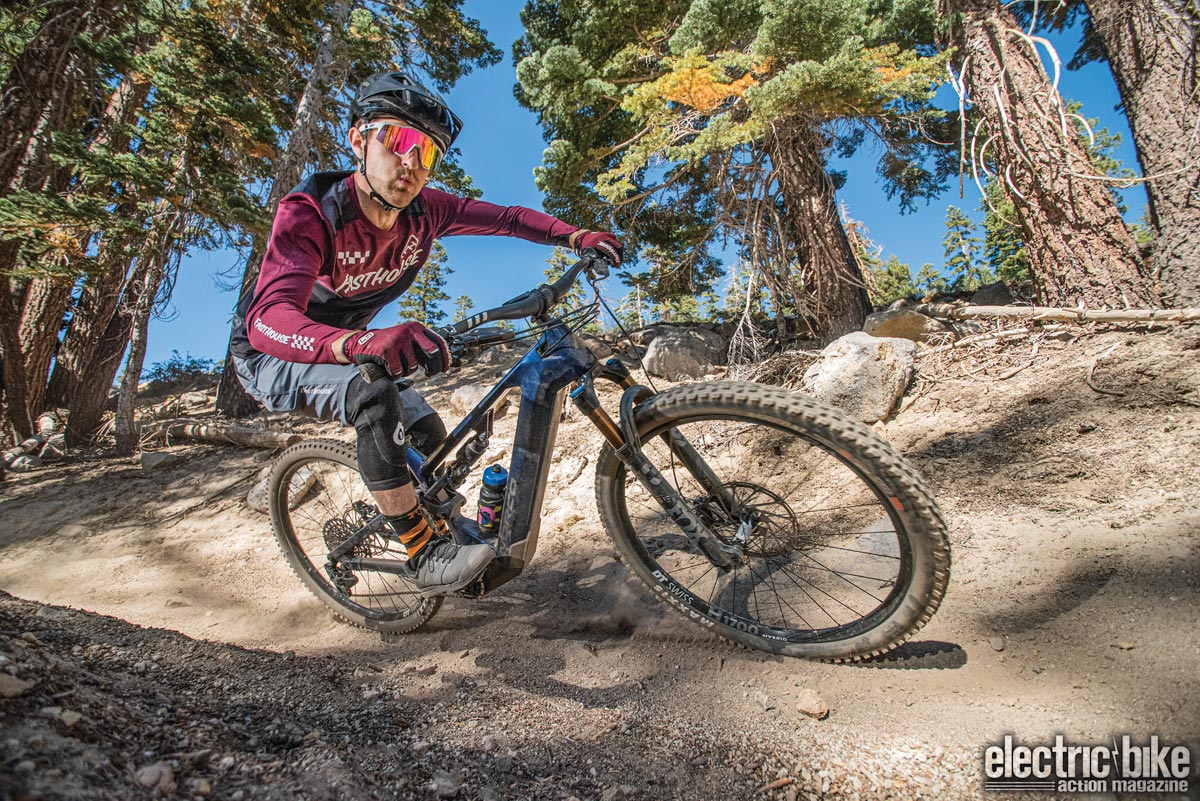
Photos by Traece Craig
The Canadian brand Norco brought the heat for 2022 with its updated VLT line of e-mountain bikes. Norco will offer a shorter-travel, trail-style Fluid VLT; an enduro, heavy-hitting Range VLT; and the Sight VLT. Norco offered Mountain Bike Action a ride on its latest Sight VLT, which will fit somewhere between the Fluid and the Range. Some key points have been upgraded. If you’re at all familiar with the 29er version of the 2021 Sight VLT, you will notice similarities with the newest edition. One of the big changes is that there are three different battery sizes that Norco lets you custom select. Also, a redesigned rear suspension, room for water bottles and a new Shimano motor put an up-to-date shine on the Sight.

DRIVE SYSTEM
Shimano’s lighter and more powerful EP8 increases overall assist from 350 percent to 400 percent versus the previous E8000 unit. The assist has gone up from 70Nm to 85Nm. The big story with this bike and the rest of the VLT line is that the bikes are offered with three different battery sizes: 540 Wh, 720 Wh and a massive 900 Wh battery. The beautiful thing is there will no longer be a need for an external add-on battery. The company that makes the batteries uses the same cell technology Tesla uses in its electric cars to get the weight down. As a result, the 540 Wh weighs 7 pounds, the 720 Wh is 8.84 pounds, and the 900 Wh is 10 pounds. For reference, Norco’s 8.84-pound 720 Wh battery is really close to Shimano’s 630 Wh, 8.15-pound battery. When you buy the bike, you can decide which battery you’re going to purchase with it. Norco dealers will either have them on hand to choose from or will order from Norco. As one might imagine, the larger batteries cost more than the smaller ones: 540 Wh, $849; 720 Wh, $1049; 900 Wh, $1249. The hardware that is attached to the battery will also be sold with any purchase of an additional battery.
“A 220mm rotor in the front helps substantially compared to SRAM Code brakes with just a 200mm rotor.”
When taking out the battery at the bottom of the frame, it’s just one bolt, but the plastic guard on the end of the battery is very pointy and downright sharp. Removal is easy once the bolt is taken out, but when putting it back in, it takes a second to line up the bolt and start screwing it in. Luckily, it’s a very big bolt and should be hard to cross-thread. One major benefit of the bolt is that it holds the battery in a fixed position. Also, the tight space that the battery fits in keeps it from rattling when hitting rough sections.
THE FRAME
The top-of-the-line navy blue model we tested has a carbon front triangle with relatively long 462mm aluminum chainstays. It comes with a slack head tube angle of 64 degrees, which seems to be a sweet spot for bikes designed to be more versatile than designated trail bike or enduro models. The bottom-bracket height is 350mm, which isn’t the lowest we’ve tested. Surprisingly, it doesn’t give the bike a tall feel. The wheelbase is on the longer side for a large at 1292mm. There is plenty of room in the cockpit, with a reach of 467mm. Norco clocked the motor upward in the frame in order to accommodate the battery coming out of the bottom of the frame. This kept Norco from having to cut a long hole in the downtube length-wise and helped maintain the desired stiffness. Another advantage of that design was that helped create the space needed to employ Norco’s lateral rear-suspension design. That also ended up leaving room on the frame for two water-bottle bosses.
THE BUILD
Norco offers two carbon builds and two aluminum builds. The C1 version we are testing is Norco’s top-of-the-line offering. Suspension duties are handled by a Fox 36 Factory, Grip2 160mm travel forks and Factory Float X2. For a wide range of gears, the drivetrain consists of a 34T front chainring driving a SRAM Eagle XG 1275, 10-52T cassette. It also uses DT Swiss H1700 wheels that are built specifically for e-mountain bikes. The rims are laced up with DT Swiss 350H hubs. This is a proven combo, even on e-bikes. Norco went with a 2.5-inch Maxxis Assegai up front and a 2.4-inch Maxxis Dissector in the rear. On the handlebar, you’ll get a SRAM GX Eagle single-click shifter that’s paired to a X01 Eagle derailleur. Wide, 800mm Deity carbon handlebars are mounted to a CNC alloy, 40mm stem. Norco built the bike with SRAM Code RSC brakes with a 220mm Centerline rotor in front and 200mm in the rear. The 220mm rotor in the front helps substantially compared to SRAM Code brakes with just a 200mm rotor. An Ergon SM-10 E-Mountain Sport saddle is mounted to a 34.9mm OneUp adjustable dropper with 170mm of travel.
SUSPENSION
Norco changed its shock design from the vertical orientation on the previous Sight to a horizontal layout on this new one. Even with the shock position change, the suspension is still a four-bar, Horst-link design. Norco claims the horizontal shock layout allowed them to reach their kinematic goals. This design also gave Norco more room in the triangle for two medium water bottles.
CLIMBING
The three power modes are set up so that Eco feels like almost nothing; Trail mode feels like a tad more than that. Once in Boost mode, you’re given all the juice, which is nice but a drastic jump up from Trail mode. Some will want to go to the app to personalize their power settings.
The 10-52T cassette is a big range and will allow you to spin up as steep a grade as you can find. Its EP8 motor has enough torque to get you up those steep grades, assuming you can keep your balance. When tackling rocky climbs, the suspension seems to cooperate well. The suspension has a plush and comfortable initial feel but doesn’t squat too much when you need to lunge forward. A majority of our Sight testing was with the 900 Wh battery. It was surprising how well the bike handled with the heavier 900wh battery. When we ventured out on a Boost-only ride with about 3000 feet of climbing, we only used one of five bars of battery—and we were pushing our friends on non-electric-assist bikes up the big climbs just for fun, too. The bike did, however, feel a little sluggish when trying to hop over rocks or logs going uphill. This feel could be due to the length of the bike or the weight from the bigger battery, because when we swapped to a smaller 540 Wh version, the 3-pound difference wasn’t huge but was definitely noticeable.

The longer chainstays effectively put the rider’s weight further from the rear wheel. One of our lighter test riders said he was searching for traction on loose climbs by sliding back on the saddle. Taller, heavier test riders, however, felt they were able to keep a fairly centered position on steep and loose climbs.

DESCENDING
Cornering was impressive, particularly in flowing bowl turns, but not so much on really tight switchbacks. Tight corners required more care and a slower speed to limit the front wheel washing out towards the later part of 180-degree, tight switchbacks. The amount of confidence we had everywhere else was abundant, though. We were able to roll over rock gardens and tree roots without losing that planted feel. When we encountered big drops or chunky sections, the bike was as forgiving as any e-bike we’ve tested. One of our test riders felt the front end loading more than he expected in steep terrain. We thought the culprit might have been a combination of longer chainstays and the 900 Wh battery, with its extra weight high and forward on the bike. We tried the Sight with the lighter battery, and it was noticeable that the bike felt more maneuverable, but it wasn’t as dramatically different as we expected.

Sometimes, 36mm stanchion forks can feel a little bit flexible in rough sections on heavier e-bikes; however, that wasn’t the case on this one. We had plenty of confidence on high-speed, rough descents. We went to Norco’s website and got the bike more dialed in with the Ride Aligned app. It’s an app that helps you set all the rebound, compression and air-pressure settings. Norco claims that the app will help riders have the feel that was intended when Norco’s engineers designed the bike. The app got us very close to our ideal setting and proved to be a great starting point. Using the app could be crucial for those not familiar with the fork’s Grip2 damper and the Float X2 shock’s high- and low-speed damping adjustments.
MODS AND UPGRADES
The SRAM Code brakes didn’t bite quite as hard as we would like, particularly in the rear. Plus, we managed to get the rear hot enough on a long descent to experience fade and the stink of hot brakes. The fronts are okay with the 220mm rotor, but we still think some more powerful brakes would be even better.

BOTTOM LINE
Norco really took a big leap forward for ’22, and it’s safe to say that the Sight is one of the most stable-feeling e-mountain bikes we’ve ridden. Yes, it’s long, but don’t let that deter you. This bike is especially stable at high speeds and in rough conditions. There was never a moment when we felt held back because of the long feel of the bike. The look of the bike is also spectacular, with unique angles and a seamless downtube. If you don’t know which battery size to go with, don’t overthink it. The 900 Wh is not out of the question, even with the extra weight; however, if you’re after pure performance, you might consider the two lighter options.
NORCO SIGHT VLT C1
Price: $9448 with 540 Wh battery
Weight: 56.4 pounds with 900 Wh battery (no pedals)
Sizes: XS, S, M, L, XL
Frame tested: Carbon front triangle and seatstay, aluminum chainstay
Shock: Fox Factory Float X2
Fork: Fox 36 Factory Kashima, Grip2, 160mm
Wheelset: DT Swiss H 1700, DT Swiss 350H hubs
Tires: 2.4″ Maxxis Disector rear/2.5” Maxxis Assegai front
Seatpost: 34.9mm OneUp adjustable dropper/170mm of travel
Handlebar: 800mm Deity carbon
Stem: CNC alloy, 40mm
Grips: DMR DeathGrip A20 soft, thin
Headset: FSA No.55R1 sealed bearing
Brakes: SRAM Code RSC, 4-piston
Rotors: SRAM CenterLine, 200mm rear/SRAM CenterLine, 220mm front
Rear derailleur: SRAM X01 Eagle
Shifters: SRAM GX Eagle Single Click
Crankset: Shimano FC-M8150 E-MTB, 34T Eagle Ring, 165mm
Cassette: SRAM Eagle XG 1275, 10-52T
Chain: SRAM GX Eagle
Chainring: 34T
Controller: Shimano display
Motor: Shimano EP8
GEOMETRY
Head tube angle: 64°
Reach: 485mm (19.1″)
Seat tube: 440mm (17.3″)
Head tube length: 120mm (4.7″)
Effective seat tube angle: 77.7º
Bottom bracket height: 350mm (13.8″)
Chainstay length: 462mm (18.1″)
Wheelbase: 1292mm (50.9″)
FOLLOW US on…
Facebook at /YourBestLifeGoods
Instagram at @YourBestLifeGoods
Twitter at @YBLGoods
Pinterest at YBLGoods
LinkedIn at YBLGoods

